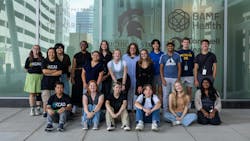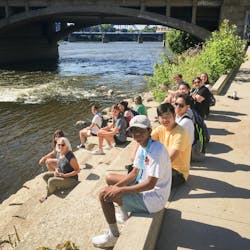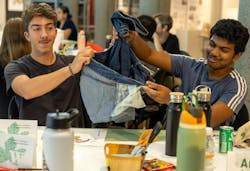Wege Prize Gets Students Thinking About Design Solutions
Key Highlights
- Participants learn to apply whole-systems design thinking and circular economy principles to real-world challenges.
- Students produce portfolio-quality work, gain mentorship, and expand career opportunities through community engagement.
- Program shows that empowering youth early can lead to meaningful contributions toward a sustainable and equitable future.
Can we empower young people to address complex problems with design solutions that build a better future for people and the planet?
The Wege Prize shows we can. Each year, we’ve inspired teams of college and university students from around the world to collaborate across cultural and institutional boundaries to redesign the way economies work. Taking on today’s “wicked problems”—including poverty, hunger, and environmental degradation—they’ve developed circular economy solutions that reduce waste, regenerate natural systems, and keep materials in circulation and out of landfills.
Since 2013, this forum has been led by Ferris State University’s Kendall College of Art and Design (KCAD) with the support of the Wege Foundation. It has been awarding cash prizes for innovative, practical ideas for services and products—everything from a leather substitute made from banana peel waste to new protein sources that address hunger to acoustic partitions made from palm fronds.
If college students can effect change in such powerful ways, we thought, why not help prepare high school students to help power the circular economy of the future, too? So we did. Five years ago, Wege Prize devised an offshoot that gets students thinking about addressing those wicked problems earlier in their academic trajectories. The result, Wege Prize High School Collaborative Studio, just completed its fifth annual summer program.
Examples of their on-location tours and learning experiences included:
- John Ball Zoo, where the students learned about wildlife conservation and inclusive, universal design for a public place.
- Common Object Studio, a specialist in sustainable and regenerative industrial design, where a hands-on workshop illuminated how furniture design can create closed loops using local materials.
- BAMF Health, where participants witnessed an innovative medical start-up with the world’s first vertically integrated platform for intelligence-based theranostic medicine.
- Grand Rapids Public Museum, where they were introduced to the Grand River Restoration, a 2.5-mile project to reintroduce rapids—and aquatic habitat diversity—to this major waterway.
- Kids′ Food Basket, where students got hands-on exposure to farmwork and food distribution, nourishing needy who face a world of food insecurity.
During this two-week journey, the students formed four teams, all working under the guidance of qualified facilitators, to research, conceptualize, and develop solutions for wicked problems of their interest. They learned to work through the lens of whole-systems design thinking, sustainable development, and the circular economy—just as leading design professionals do—to address challenges both global and local.
Wege Prize High School Collaborative Studio culminated in final-day team presentations of their completed concepts to an audience of community leaders. The students parted with portfolio-quality design work, letters of recommendation, and valuable professional mentoring. Just as important, the teens built skills, knowledge, experience, perspective, and real network connections that expand career opportunities—and inspire them to more actively engage with the world around them.
Putting Students on the Path to Design
About the Author
Gayle DeBruyn
Gayle DeBruyn, M.M., is a Professor and Program Chair for the Master of Arts in Design Program at Ferris State University’s Kendall College of Art and Design, known as KCAD, in Grand Rapids, Michigan. DeBruyn is widely published and has earned awards for sustainable design leadership and academic achievements. She helped create Wege Prize and Wege Prize High School Collaborative Studio and has been leading those programs since their inception.






